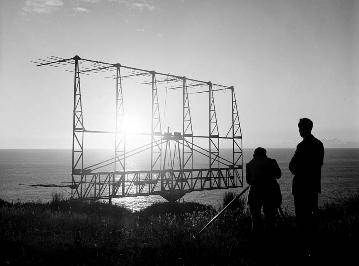| 30th of August 2015 |
|---|

|
| Radio Astronomy at Dover Heights |
| by Jessica Chapman (CASS) |
| Dover Heights in the eastern suburbs of Sydney was the site of remarkable discoveries in radio astronomy in the post-war years. In the mid-1940s very little was known about radio waves from space. From 1946 to 1954 scientists and engineers from the CSIRO Division of Radiophysics built a range of radio antennas at Dover Heights and developed new ways of collecting radio data. Many major discoveries were made and these established Australia as a world leader in the emerging new science of radio astronomy.
This photograph shows a 12-element Yagi antenna on the cliff top at Dover Heights. This was used in 1952 to 1953, at a frequency of 100 MHz, to search for astronomical radio sources. The observations were taken using a technique called sea interferometry where an antenna detects radio waves directly from the source and also detects radio waves reflected by the sea. This was the last sea interferometry survey carried out at Dover Heights. The results were published in 1954 by John Bolton, Gordon Stanley and Bruce Slee (Australian Journal of Physics, vol. 7, p.110) as a catalogue of 104 discrete radio sources. The Dover Heights discoveries heralded a new era in astronomy. By looking at the radio waves emitted from objects in space, we can probe deeper and reveal the very distant universe. Since the first discoveries at Dover Heights of radio emission from distant galaxies, radio waves have been used to explore the entire cosmos, from the Sun and planets in our solar system, to stars and gas in our Galaxy, and beyond to other galaxies and the most distant reaches of the Universe. For more information see here . |